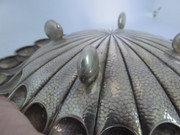Because I'm not very familiar with the austro hungarian silver trade here is my first question. As these two makers where located in vienna is it possible that silverwares made in Vienna and brougth to Pest get the assay mark from Pest? If not, is a maker "JR" (?) known as member of the gold and silversmith guild in Pest?
My second question is related to the design. I saw a lot of similar designed pieces in the silvershops in Pest but but none of those I asked had a name for this specific design or the name of the designer. But they all told me that this design is very typical for silver from Pest.
Thanks for any help!




